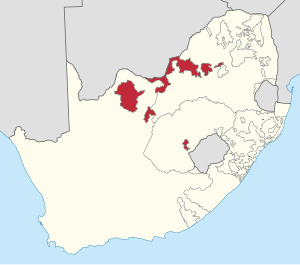Bophuthatswana coup d'état of 1994
| 1994 Bophuthatswana crisis | |||||||||
|---|---|---|---|---|---|---|---|---|---|
| Part of the end of apartheid and drawdown to South African general election, 1994 | |||||||||
 The tribal homeland of Bophuthatswana in early 1994 |
|||||||||
|
|||||||||
| Belligerents | |||||||||
|
|
|
||||||||
| Commanders and leaders | |||||||||
|
|
|
||||||||
| Strength | |||||||||
|
|
|
||||||||
| Casualties and losses | |||||||||
|
Volksfront: 1 killed AWB: 4 killed, 3 wounded |
BDF: 50 dead, 285 wounded | ||||||||
Opposition-SADF victory
![]() Government of Bophuthatswana
Government of Bophuthatswana![]() Afrikaner Volksfront
Afrikaner Volksfront
The 1994 Bophuthatswana crisis was a major political crisis which began after Lucas Mangope, the president of Bophuthatswana, a South African bantustan created under apartheid, attempted to crush widespread labour unrest and popular demonstrations demanding the incorporation of the territory into South Africa pending multiracial elections later that year. Violent protests immediately broke out following President Mangope's announcement on March 7 that Bophuthatswana would boycott the South African general elections. These escalated into a civil service strike and a mutiny in the local armed forces, which was complicated by the arrival of right-wing Afrikaner extremists ostensibly seeking to preserve the Mangope government. The chaos lasted about four days before the president bowed to pressure and agreed to allow participation in the upcoming elections. However, Mangope once again reversed his decision. The South African Defence Force (SADF) responded by deposing him and restoring order on March 12.
The Bophuthatswana Crisis highlighted the deep unpopularity of the Mangope government and the bantustan system among most of its residents. It has been remembered largely for the shooting of three Afrikaner Weerstandsbeweging (AWB) militants by a black police officer. This proved to be a public relations disaster for the AWB and demoralised the movement, which was then intent on preserving white minority rule.
...
Wikipedia
